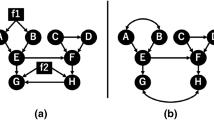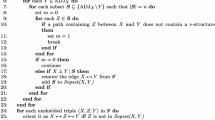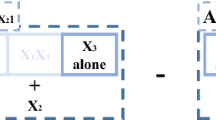Abstract
Discovering causal relationships from data affected by latent confounders is an important and difficult task. Until recently, approaches based on causal function models have not been used to present variable pairs whose relationships are affected by latent confounders, although some constraint-based methods are possible. Recently, a method based on causal function models called repetitive causal discovery (RCD), which infers causal relationships under the assumption that latent confounders exist, has been proposed. However, it has been pointed out that there are causal models RCD cannot identify. This problem is caused by the part of the RCD algorithm that extracts the set of ancestors of each observed variable. In this paper, we investigate the modifications to the RCD algorithm and propose an improved algorithm of RCD which we call improved RCD (I-RCD).The RCD algorithm removes the influence of the common ancestors of two variables from them when inferring the causal relationship between them, whereas the I-RCD removes the influence of the all ancestors of each variable from both variables respectively. The experimental results show that I-RCD accurately infers variable pairs with the same unobserved common causes and identify the direct causal relationships between observed variables compared to RCD.



Similar content being viewed by others
References
Chickering DM (2002) Optimal structure identification with greedy search. J Mach Learn Res 3(Nov):507
Colombo D, Maathuis MH, Kalisch M, Richardson TS (2012) Learning high-dimensional directed acyclic graphs with latent and selection variables. Ann Stat 40(1):294. https://doi.org/10.1214/11-AOS940
Gretton A, Fukumizu K, Teo CH, Song L, Schölkopf B, Smola AJ (2008) A kernel statistical test of independence. In: Platt JC, Koller D, Singer Y, Roweis ST (eds) Advances in neural information processing systems 20. Curran Associates, Inc., pp 585–592
Hoyer PO, Shimizu S, Kerminen AJ, Palviainen M (2008) Estimation of causal effects using linear non-Gaussian causal models with hidden variables. Int J Approx Reason 49(2):362. https://doi.org/10.1016/j.ijar.2008.02.006 (Special Section on Probabilistic Rough Sets and Special Section on PGM’06)
Hoyer PO, Janzing D, Mooij J, Peters J, Schölkopf B (2009) Nonlinear causal discovery with additive noise models. In: Koller D, Schuurmans D, Bengio Y, Bottou L (eds) Advances in neural information processing systems 21. Curran Associates, Inc., pp 689–696
Maeda T N, Shimizu S (2021) Causal additive models with unobserved variables. In: de Campos C, Maathuis MH (eds) Proceedings of the thirty-seventh conference on uncertainty in artificial intelligence, proceedings of machine learning research, vol. 161, (PMLR), proceedings of machine learning research, vol. 161, pp 97–106. https://proceedings.mlr.press/v161/maeda21a.html
Maeda TN, Shimizu S(2020) RCD: repetitive causal discovery of linear non-Gaussian acyclic models with latent confounders. In: Proceedings of the twenty third international conference on artificial intelligence and statistics (AISTATS2020), pp 735–745
Maeda TN, Shimizu S (2021) Repetitive causal discovery of linear non-Gaussian acyclic models in the presence of latent confounders. Int J Data Sci Anal. https://doi.org/10.1007/s41060-021-00282-0
Moneta A, Entner D, Hoyer PO, Coad A (2013) Causal inference by independent component analysis: theory and applications*. Oxf Bull Econ Stat 75(5):705
Mooij J, Janzing D, Peters J, Schölkopf B (2009) Regression by dependence minimization and its application to causal inference in Additive Noise Models. In: Proceedings of the 26th annual international conference on machine learning. ACM, New York, ICML ’09, pp 745–752. https://doi.org/10.1145/1553374.1553470
Ogarrio JM, Spirtes P, Ramsey J (2016) A hybrid causal search algorithm for latent variable models. In: Conference on Probabilistic Graphical Models, pp 368–379
Peters J, Mooij JM, Janzing D, Schölkopf B (2014) Causal discovery with continuous additive noise models. J Mach Learn Res 15(1):2009
Rosenström T, Jokela M, Puttonen S, Hintsanen M, Pulkki-Råback L, Viikari JS, Raitakari OT, Keltikangas-Järvinen L (2012) Pairwise measures of causal direction in the epidemiology of sleep problems and depression. PLoS One 7(11):1. https://doi.org/10.1371/journal.pone.0050841
Shapiro SS, Wilk MB (1965) An analysis of variance test for normality (complete samples). Biometrika 52(3/4):591
Shimizu S, Hoyer PO, Hyvärinen A, Kerminen A (2006) A linear non-Gaussian acyclic model for causal discovery. J Mach Learn Res 7(Oct):2003
Shimizu S, Inazumi T, Sogawa Y, Hyvärinen Y, Kawahara Y, Washio T, Hoyer PO, Bollen K (2011) DirectLiNGAM: a direct method for learning a linear non-Gaussian structural equation model. J Mach Learn Res 12(Apr):1225
Smith SM, Miller KL, Salimi-Khorshidi G, Webster M, Beckmann CF, Nichols TE, Ramsey JD, Woolrich MW (2011) Network modelling methods for FMRI. Neuroimage 54(2):875
Spirtes P, Glymour C (1991) An algorithm for fast recovery of sparse causal graphs. Soc Sci Comput Rev 9(1):62
Spirtes P, Meek C, Richardson T (1999) Causal discovery in the presence of latent variables and selection bias. In: Cooper GF, Glymour CN (eds) Computation, causality, and discovery. AAAI Press, pp 211–252
von Eye A, DeShon RP (2012) Directional dependence in developmental research. Int J Behav Dev 36(4):303. https://doi.org/10.1177/0165025412439968
Wang YS, Drton M (2020) Causal discovery with unobserved confounding and non-Gaussian data. ar**v preprint ar**v:2007.11131
Yamada M, Sugiyama M (2010) Dependence minimizing regression with model selection for non-linear causal inference under non-Gaussian noise. In: Twenty-Fourth AAAI Conference on Artificial Intelligence
Funding
Takashi Nicholas Maeda has been partially supported by Grant-in-Aid for Scientific Research (C) from Japan Society for the Promotion of Science (JSPS) #20K19872.
Author information
Authors and Affiliations
Corresponding author
Ethics declarations
Conflict of interest
The author declare no conflicts of interest associated with this manuscript.
Additional information
Communicated by Shuichi Kawano.
Publisher's Note
Springer Nature remains neutral with regard to jurisdictional claims in published maps and institutional affiliations.
About this article
Cite this article
Maeda, T.N. I-RCD: an improved algorithm of repetitive causal discovery from data with latent confounders. Behaviormetrika 49, 329–341 (2022). https://doi.org/10.1007/s41237-022-00160-4
Received:
Accepted:
Published:
Issue Date:
DOI: https://doi.org/10.1007/s41237-022-00160-4




